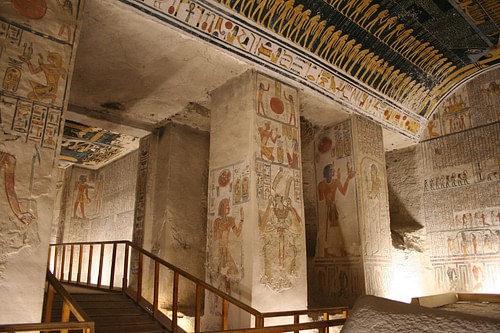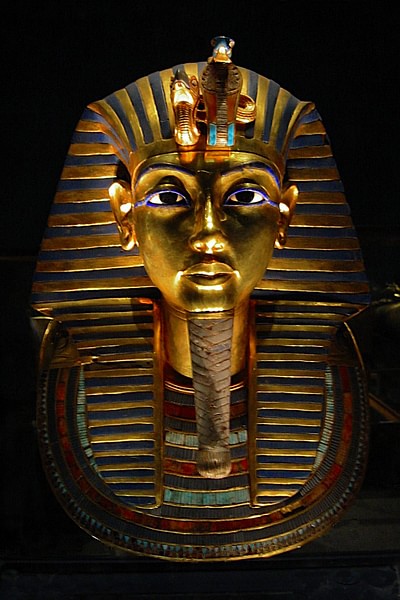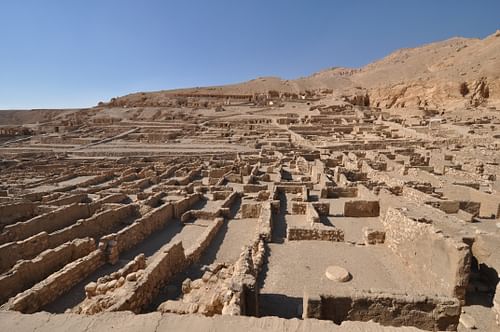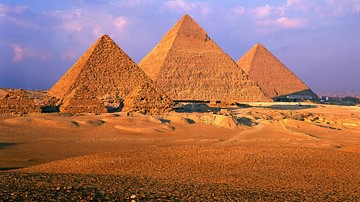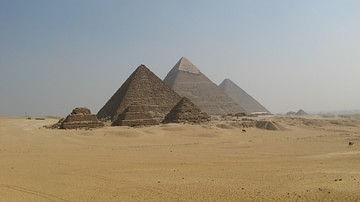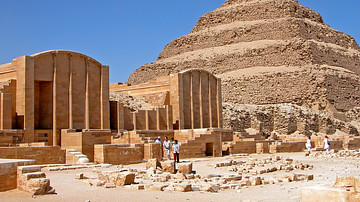The tombs of the great kings and nobles of Egypt were built to safeguard the corpse and possessions of the deceased for eternity and yet, while many have endured for thousands of years, their contents often disappeared relatively quickly. Tomb robbing in ancient Egypt was recognized as a serious problem as early as the Early Dynastic Period (c. 3150 - c. 2613 BCE) in the construction of the pyramid complex of Djoser (c. 2670 BCE). The burial chamber was purposefully located, and the chambers and hallways of the tomb filled with debris, to prevent theft, but even so, the tomb was broken into and looted; even the king's mummy was taken.
This same paradigm can be seen in the construction of the pyramids at Giza during the Old Kingdom of Egypt (c. 2613 – 2181 BCE) and with the same results. Although the Great Pyramid and the others still stand, none of the treasures buried with the kings of the 4th Dynasty – Khufu, Khafre, and Menkaure – have been found in the structures and neither were any of the bodies. Execration texts (curses) on the doors and lintels of tombs were supposed to prevent such thefts, and the Egyptian belief in a life after death – from which the dead could interact with the living – should have encouraged greater respect and fear of a haunting in would-be thieves but, evidently, neither were strong enough incentives to curb the temptation of easy riches with little risk. Egyptologist David P. Silverman writes:
It was no secret that, as the burial process grew more elaborate, so did the value of the grave goods interred with both royal and non-royal mummies. Gilded coffins, amulets of precious stones, exotic imported artifacts all proved too tempting for thieves. When embalmers began to include protective amulets, precious stones, gold, or silver within the mummy wrappings, even the deceased's corpse came under threat. Robbers probably attacked royal tombs soon after the king's funeral, and there is evidence of corruption among the necropolis employees charged with protecting the tombs. (196)
By the time of the New Kingdom of Egypt (c. 1570 - c. 1069 BCE) the problem had grown so severe that Amenhotep I (c. 1541-1520 BCE) commissioned a special village to be constructed near Thebes with easy access to a new royal necropolis, which would be more secure. This new burial place is known today as the Valley of the Kings and the nearby Valley of the Queens and the village is Deir el-Medina. They were located outside of Thebes in the desert – far from easy access – and the village was intentionally isolated from the Theban community at large, but even these measures would not be enough to protect the tombs.
The Wealth of the Kings
The most famous tomb from ancient Egypt is that of the New Kingdom pharaoh Tutankhamun (1336-1327 BCE) which was discovered by Howard Carter in 1922 CE. The wealth of Tutankhamun's tomb is estimated at around three-quarters of a billion dollars. His golden coffin alone is appraised at $13 million. Tutankhamun died before the age of 20 and had not yet amassed the kinds of riches great kings like Khufu or Thutmose III or Seti I or Ramesses II would have had. The riches buried with a king like Khufu would have been far greater and more opulent than anything in Tutankhamun's tomb.
The only reason Tutankhamun's tomb remained relatively intact (it was actually broken into twice in antiquity and robbed) was that it was accidentally buried by the ancient workers who built the tomb of Ramesses VI (1145-1137 BCE) nearby. Exactly how this would have happened is unknown but somehow the workers on that tomb buried the earlier one without a trace and so preserved it until the 20th century CE when Carter found it. Most tombs, however, were not so lucky and almost all were looted to one degree or another.
Egypt was a cashless society until the coming of the Persians in 525 BCE, and so the wealth looted from the tombs would not have been exchanged for money nor could it have been used in trade. One could not simply walk into the marketplace with a golden scepter, for example, and trade it for some sacks of grain because stolen goods were supposed to be reported immediately to the authorities. If someone were to accept a stolen item in trade then that person would be burdened with the task of somehow disposing of it and hope to make a profit. Most likely, the stolen items were fenced to a higher (corrupt) official, who would have paid for it in material goods and then had the gold melted down to some other form and traded it for goods or services to an artisan.
The difficulty in controlling tomb robberies was simply that the wealth entombed with the deceased was so vast and the officials tasked with keeping them safe could so easily be bought. Even if a tomb were designed to disorient a thief and the burial chamber were located deep within the earth and blocked by rubble, there was always some way around these obstacles for the resourceful thief. The location of the tombs was also quite well advertised as they either had enormous pyramids rising above them or more modest, but still elaborate, mastabas. If one were looking for quick gain then one need look no further than looting a tomb in the middle of the night.
The Place of Truth
It was largely for this reason that Amenhotep I commissioned the village known today as Deir el-Medina. Originally referenced in official documents as Set-Ma'at (The Place of Truth), Deir el-Medina and the nearby necropolises were supposed to solve the problem of tomb theft once and for all. The workers of the village would create the tombs and protect their creation and, since they relied on the state for their wages and homes, they would be loyal and discreet regarding the location of the tombs and the amount of treasure to be found within.
Although this paradigm may have worked in the early days of the community, it did not endure. Deir el-Medina was not a self-sufficient village – it had neither agricultural development nor a water supply – and relied on monthly deliveries of supplies in payment from Thebes and daily import of water from the Nile. These supplies were largely standardized, not luxurious, and did not always arrive on time. The citizens of the village made their own crafts and bartered with each other, but the temptation to take treasure from a tomb, walk the hour or so to Thebes, and exchange it for some luxury proved too great for some of the workers. Those who were supposed to protect the tombs used the same tools they had built them with to break in and rob them.
The living/working relationship at Deir el-Medina worsened c. 1156 BCE during the reign of Ramesses III when the monthly shipments were first late and then stopped arriving completely. These were not luxuries or bonuses but the wages of the workers – paid in food, supplies, and beer – which they needed to live. The failure of the supply system led to the first labor strike in history when the workers put down their tools, walked off the job, and marched on Thebes to demand their pay.
Although the strike was effective and the villagers received their wages, the underlying problem of making sure supplies reached the village was never addressed. Payments to Deir el-Medina would be late again and again throughout the rest of the period of the New Kingdom of Egypt as the central government steadily lost power and the bureaucracy which maintained it fell apart.
Tomb Robber's Confession
In this climate, many more people turned to tomb robbing as a living. In spite of the accepted belief in an afterlife and the power of execration texts which guaranteed a bad end for anyone who robbed a tomb, the activity went on with greater frequency than before. Silverman writes:
Criminals convicted in the late Ramesside Period (c. 1120 BCE) testified to the theft of objects from tombs, the looting of precious metals from coffins and mummies, and the destruction of royal corpses. Other texts record carousing on royal burial equipment and blasphemous activity by individuals. Such behavior suggests that at least part of the population had little fear of repercussions in this world or from the gods in the next. (111)
Confessions from criminals convicted of tomb robbing multiply toward the end of the New Kingdom. The courts seem to have dealt with these cases on an almost daily basis. The Mayer Papyri (c. 1108 BCE) records a number of cases detailing how those caught desecrating and robbing tombs were "tortured at the examination on their feet and their hands to make them tell the way they had done exactly" (Lewis, 257). Testimonies are recorded by police officers and chiefs regarding the suspects and how they were caught. Punishments are most often recorded as beatings with a rod (bastinade) on the soles of the feet and flogging but could be as severe as amputation of the hands and nose or even death by impalement or burning.
These punishments were still no deterrent. The confession of one man named Amenpanufer, a mason at Deir el-Medina, describes how the tombs were robbed and also how easy it was to escape punishment if arrested and return to one's comrades to rob again. His confession is dated c. 1110 BCE:
We went to rob the tombs as is our usual habit and we found the pyramid tomb of King Sobekemsaf, this tomb being unlike the pyramids and tombs of the nobles which we usually rob. We took our copper tools and forced a way into the pyramid of this king through its innermost part. We located the underground chambers and, taking lighted candles in our hands, went down.
We found the god lying at the back of his burial place. And we found the burial place of Queen Nubkhaas, his consort, beside him, it being protected and guarded by plaster and covered with rubble.
We opened their sarcophagi and their coffins, and found the noble mummy of the king equipped with a sword. There were a large number of amulets and jewels of gold on his neck and he wore a headpiece of gold. The noble mummy of the king was completely covered in gold and his coffins were decorated with gold and with silver inside and out and inlaid with precious stones. We collected the gold that we found on the mummy of the god including the amulets and jewels which were on his neck. We set fire to their coffins.
After some days, the district officers of Thebes heard that we had been robbing in the west and they arrested me and imprisoned me in the office of the mayor of Thebes. I took the twenty deben of gold that represented my share and I gave them to Khaemope, the district scribe of the landing quay of Thebes. He released me and I rejoined my colleagues and they compensated me with a share again. And so I got into the habit of robbing the tombs. (Lewis, 256-257)
The tone of Amenpanufer's confession is quite comfortable as though he has nothing to fear. His claim that he paid the district scribe may be interpreted as a fine but most scholars recognize it as a bribe since this practice was quite common. The fate of Amenpanufer after his confession is unknown. The deben he mentions was the monetary unit of worth in ancient Egypt prior to the introduction of a cash economy c. 525 BCE by the Persians; and the god mentioned in the tomb of Sobekemsaf would have been the king's personal deity who watched over him in the same way the golden statues of Isis, Nephthys, Neith, and Serket were placed in Tutankhamun's tomb.
The complete lack of regard Amenpanufer shows in recounting the tomb's looting, including the burning of the elaborate coffins, shows how little these tomb robbers cared about repercussions from the afterlife and the ease with which he found his freedom exemplifies why tomb robbing became such a popular way to make a living: if one had enough gold from the heist, one could buy one's self out of jail, be reimbursed by one's comrades, and go back to business as usual.
Conclusion
In spite of their best efforts, the authorities of ancient Egypt never were able to resolve the problem of tomb robbing. Their best effort, Deir el-Medina, started to fail even before the decline of the New Kingdom and their earlier efforts were clearly unsuccessful; otherwise, there would have been no reason to construct the village and new necropolises.
Although some scholars have pointed to a decline in religious belief during the Middle Kingdom of Egypt (2040-1782 BCE) as a reason for the increase in tomb robbing, this claim is untenable. The evidence for a lack of religious belief in the Middle Kingdom comes from literary works, not inscriptions or official records, and can be interpreted in a number of different ways. Further, as noted, the problem of tomb robbers existed long before the Middle Kingdom.
Ancient Egyptians robbed the tombs of the wealthy for many of the same reasons people rob others in the present day: excitement, money, and a kind of empowerment in taking what one does not own. The argument that these people should have behaved better considering their belief system also does not hold up since it seems quite clear that many people, throughout history, may profess a belief they cannot live. All of the threats and all of the promises of punishment in the afterlife and terrible hauntings in this one could not deter anyone when, given the chance, they could break into a tomb and walk back out with a king's treasure.
